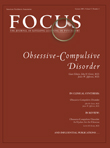Ask the Expert: Obsessive-Compulsive Disorder
I have a patient in dynamic psychotherapy for relationship issues. This patient has a number of subthreshold compulsive symptoms that do not affect her functioning but are notable (for example, all the cans in her pantry must be in alphabetical order and face the same way). How do I evaluate these symptoms in relationship to the diagnosis of obsessive-compulsive disorder and potential treatment?
As a clinician and researcher in obsessive-compulsive disorder (OCD) for more than 20 years, I clearly understand that there are both biological and psychological components to OCD. Time and again, however, I am surprised at the difficulty I have in eliciting symptoms from my patients and, more importantly, at the reticence patients have in seeking treatment for something they see as an emotional weakness that they should just be able to control with “will power.” Thus, in the case outlined briefly above, as for so many others, an important part of pursuing “potential treatment” is to help the patient come to grips with the notion that there is something worth treating and that you, as a psychiatrist, have means to treat their symptoms.
Therefore, the first thing to do is to explore the patient's symptoms in detail. Are their symptoms interfering with function? Ask questions such as
| •. | Why do you need to line up the cans in alphabetical order? | ||||
| •. | How much time does it take? | ||||
| •. | Do you ever find yourself late for something you were trying to get to because of the time you spend doing it? | ||||
| •. | What are your feelings about these symptoms? | ||||
| •. | Have you been late for other things because you were caught up doing things such as washing your hands over and over or checking the door to your house or your car to make sure it is locked? | ||||
| •. | You know, at times my patients have even admitted, although they were somewhat embarrassed, that they have broken handles off doors because they checked them so many times. Has something like this ever happened to you? | ||||
As you continue to get a full understanding of the extent of symptoms and the amount of interference the symptoms cause, you should include questions about symptoms that can be most embarrassing, such as hyper-religiosity and violent thoughts. Although it is rare for the patient with OCD to act on violent thoughts, these thoughts will often lead to extensive compulsions to rid the mind of the obsessional thoughts (1).
Once you have established the extent of the obsessions and compulsions and the amount of interference they cause, it is easier to work with the patient to discuss treatment options. Although the case above as presented is “subthreshold” OCD, an in-depth interview may uncover a surprising amount of interference in daily living. The internal strife created by obsessions and compulsive thoughts or behaviors can cause problems. Not all the compulsive behaviors a patient performs to deal with obsessive thoughts are observable. Many compulsive acts can simply happen in the mind as repetitive thoughts to make the obsessional thinking go away. Mild and even moderate symptoms may easily benefit from some simple cognitive behavior therapy techniques. By addressing the symptoms in a nonjudgmental way, the patient may be motivated to pursue such treatment, an independent model such as treatment books, or computer guided CBT (2).
If on further exploration, the symptoms are causing significant impairment or are severe, then pharmacotherapy alone or, even better, in addition to CBT should be pursued (3). Selective serotonin reuptake inhibitors (SSRIs) have established efficacy, and many are easily tolerated (1, 4). At times one must use maximal doses (for instance, 200 mg of sertraline, although some patients may respond at a dose as low as 50 mg), and a duration of 6–10 weeks is often required, although some may already show a response in 4–6 weeks. It is important to discuss duration of treatment and side effects. Even though these patients tend to obsess and may worry about unanticipated side effects or the long duration of treatment before a response is seen, surprise or worry about unanticipated side effects is most often the reason that they will discontinue treatment before it is fully effective or end treatment prematurely. Thus, as part of ongoing treatment it is best to review potential side effects as medication is begun and throughout treatment, while reassuring patients that most side effects are very rare and do not have significant risk, especially in the case of SSRIs.
A very important part of treating patients with OCD symptoms is to address their reticence to seek treatment. Open-ended and focused questions, as discussed above, may reveal significant impairment. By making them aware that these symptoms are not their “fault” or “weaknesses” and teaching about the options, both pharmacological and psychological, that are available to help them, psychiatrists and patients can work together to relieve suffering caused by OCD.
1 Pato MT, Zohar J: Current Treatments of Obsessive-Compulsive Disorder 2nd ed. Washington, DC, American Psychiatric Press, Inc. Washington, D.C. 2001.Google Scholar
2 Greist JH, Marks IM, Baer L, Kobak KA, Wenzel KW, Hirsch MJ, Mantle JM Clary CM: Behavior therapy for obsessive-compulsive disorder guided by a computer or by a clinician compared with relaxation as a control. J Clin Psychiatry 2002; 63: 138– 145.Crossref, Google Scholar
3 Foa EB, Liebwitz MR, Kozak MJ, Davies S, Campeas R, Franklin ME, Huppert JD, Kjernisted K, Rowan V, Schmidt AB, Simpson HB, Tu X: Randomized, placebo-controlled trial of exposure and ritual prevention, clomipramine, and their combination in the treatment of obsessive-compulsive disorder. Am J Psychiatry 2005; 162: 151– 161.Crossref, Google Scholar
4 Pato MT, Phillips KA: Biological, pharmacological and somatic treatments of obsessive-compulsive disorder, in Brief Treatment and Crisis Intervention, vol. 3. Edited by Van Noppen B, Steketee G, Neziroglu F. Oxford, UK, Oxford University Press, 2003, pp. 275– 290.Google Scholar



